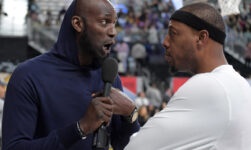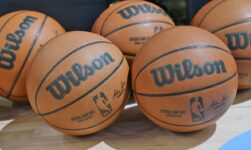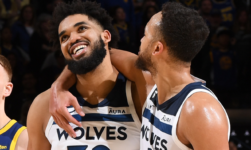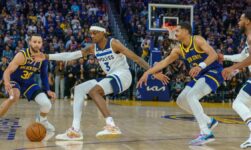BOSTON — Look at the Boston Celtics’ bench while players are going through their pregame routine and ones sees team president of basketball operations Brad Stevens talking to a player.
Turn your head for a minute and look back, and Stevens is gone – poof, vanished, an apparition to be seen again for a while.
Stevens prefers it that way, working behind the scenes, trying to improve the roster and not answer questions from meddling media, especially questions about coaching that would in any way – however unintentional – undermine first-time head coach Ime Idoka.
Operating behind the scenes is Stevens’ preferred method.
But it’s clear in his first season as Celtics president of basketball operations, he improved the roster and gave Udoka the autonomy to coach his way.
On a long flight Tuesday from San Francisco to Boston for Thursday’s Game 6, I re-listened to the Celtics’ press conference from the end of last season announcing Danny Ainge’s departure from the franchise and Stevens’ promotion from coach to front office.
I wanted to hear what was said then that offered any insight into what happened with the Celtics this season.
From Celtics owner and managing partner Wyc Grousbeck: “Brad and I spoke and committed to one another we’re going to win banner 18 or die trying. … (We) believe Brad is the person to lead us forward on the basketball side as we go after that lofty goal.”
From Ainge: “I think (Brad) was born for this. Indiana kid, basketball junkie, smart, lives the game, has many resources and has a great staff. With Brad’s leadership and his organization and his work ethic and intelligence, this is a great day for the Celtics. This is actually even a big step forward.”
OPINION: Veteran Warriors experiencing big NBA Finals advantage over youthful Celtics
GAME 5: Warriors’ Andrew Wiggins enters NBA Finals MVP discussion with another big outing
SPORTS, DELIVERED: Get latest news right in your inbox!
Brad Stevens looks on before Game 6 of the Eastern Conference finals against the Miami Heat.
Stevens said a few things that at the time passed as press conference minutia. A year later, there is insight to words Stevens spoke.
Story continues
“I know there’s a lot of work hard.”
“I’ve been doing this for eight years. I’ve been in that locker room with some of those guys for a long time. They’ll get to play for a coach with fresh new perspectives and I think that’s a good thing.”
“I’m not the story.”
Stevens recognized the roster shortcomings on a team that finished 36-36 and lost in the first round last season. Through a variety of means, Stevens had to make sure he gave Udoka a better roster than the one he had.
The second comment is interesting. Without saying it directly, Stevens perhaps recognized that someone else’s voice and methods might get through better.
Finally, Stevens doesn’t want the attention. Aside from obligations to the Celtics’ TV and radio networks, he doesn’t do many interviews.
Udoka acknowledged at the start of the Finals it’s a unique situation where the previous guy to have the coaching job is now his boss.
“With him, it’s been great,” Udoka said. “Different situation that a lot of people may not think is appealing, but I think it’s only a benefit to have a guy that’s coached for seven, eight years in the building with the same guys down the hall. Talk about every situation he’s been through and lend his support as far as that. But also step back and let me do my thing. I think it’s only been an added benefit, and in a unique situation, it’s helped out this year for sure.”
After the interview process, Stevens and Grousbeck concluded Udoka was the right coach.
“Obviously you talk about the expectations and the standard of the organization, but really basketball philosophy and where we wanted to go as an organization and the way I thought the game on both ends, the way I related to people was a big part of it, and how we could push the group forward,” Udoka said.
“So very natural in the interview process, the original Zooms and in person. With Brad, we hit it off from the get-go and thought the same way. We obviously felt comfortable, and there were some benefits of working with somebody who feels the same way.”
While Stevens improved the roster and Udoka got more out of it, don’t forget Stevens and his previous staff are partially responsible for the development of Jayson Tatum, Jaylen Brown, Marcus Smart, Grant Williams, Robert Williams and Payton Pritchard. And Ainge is responsible for drafting those players.
Stevens jumped right into the role with the coaching search, and in the offseason, Stevens traded for Al Horford. At the trade deadline, he acquired Derrick White from San Antonio. Horford and White have been key in Boston’s run to the Finals.
“I think he’s done a phenomenal job as GM,” Warriors coach Steve Kerr said. “The moves he made this year, adding Horford and Derrick White, brilliant.”
Kerr and Stevens forged a friendship before Kerr jumped to coaching and when Stevens coached at Butler.
“I actually know Brad pretty well,” Kerr said. “We connected when I was in broadcasting, and he was at Butler. We had lunch. He wanted to pick my brain about the NBA. I wanted to pick his brain about coaching. I was thinking about getting into coaching. I had done a couple of Butler games for CBS.
“And so we’ve built a relationship over the years. Just great respect for him.”
Kerr went from the front office to coaching, the opposite of what Stevens did.
“He’s somebody I think who has figured out what he wants at this stage in his life,” Kerr said. “That’s what we all have to figure out in this business. I was able to hold off on coaching until my kids were pretty much done with high school, and that’s the way I wanted it. And I think he was sort of the opposite. While he was coaching, his kids were pretty young. I know he’s got a lot more time with them now, which is important for him.
“You just have to figure out your own existence and what you want within that, and I think he’s done a good job of that.”
There will always be talk of Stevens returning to coaching if he wants. He’s really good at that, too. But also – not saying this an appointment for life – the great NBA organizations maintain continuity and stability. Ainge was there for 18 years. Stevens could have this job a long time.
He’s also unpredictable. His move from Butler to the Celtics was a stunner, as was his move from coaching to president of basketball operations. Stevens evolves and makes choices accordingly.
Perhaps Stevens’ best coaching decision was to leave coaching. At least for the time being.
This article originally appeared on USA TODAY: Brad Stevens’ moves as Celtics president help put team in Finals






